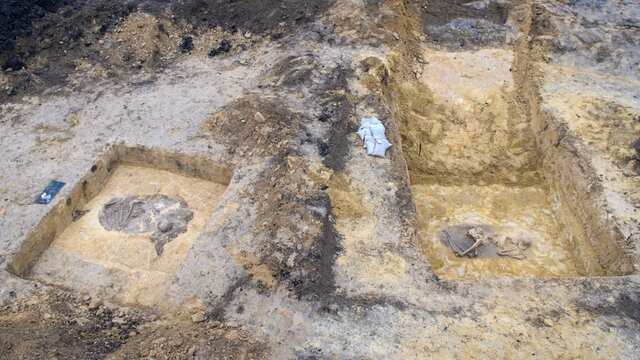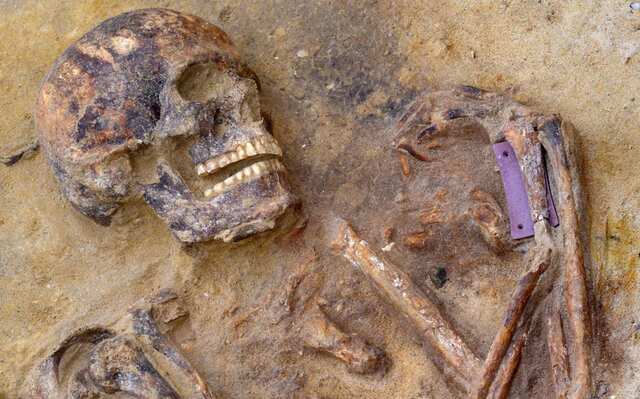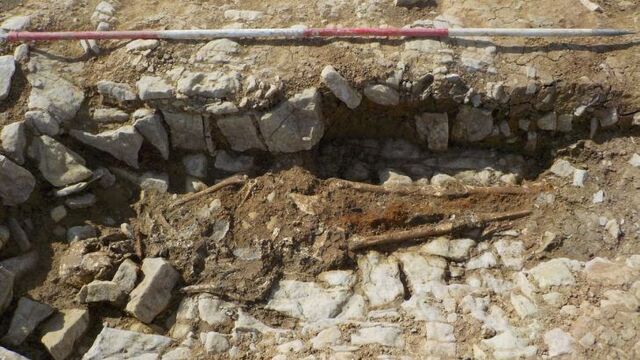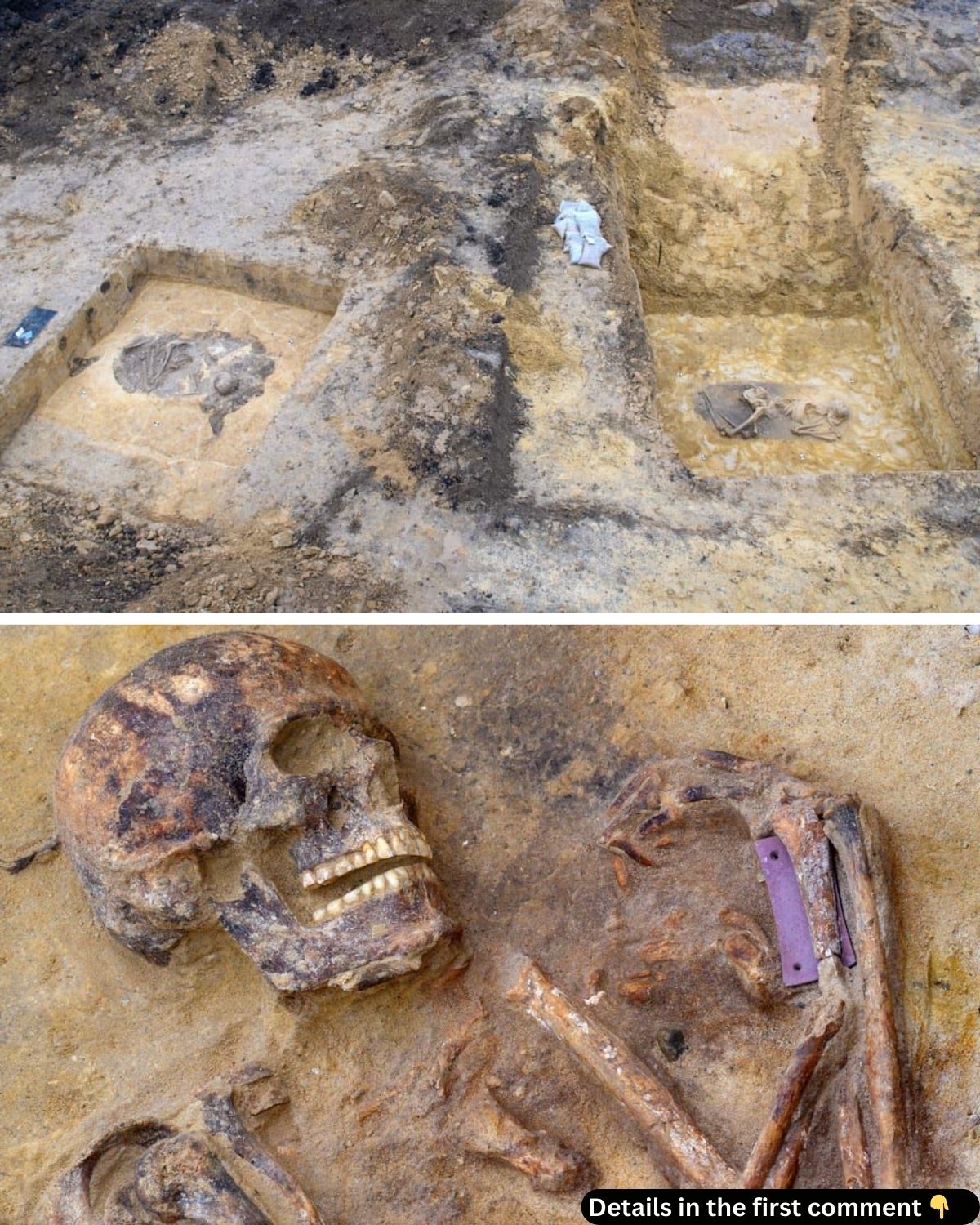In a remarkable archaeological discovery, three warrior graves dating back 4,500 years have been unearthed in Germany during the construction of a new power line. Buried in a Copper Age cemetery, the warriors’ graves reveal fascinating insights into ancient burial customs and their connection to survival in a harsh world. Among the finds is a warrior still wearing part of his armor, offering a rare glimpse into the past. This extraordinary find helps us understand the lives of those who lived long before us.
The Bell Beaker Culture: A Glimpse into an Ancient Civilization
The Bell Beaker culture, which flourished during the late Neolithic to early Bronze Age, left a lasting imprint on Europe’s archaeological landscape. Known for their distinctive bell-shaped pottery, the Bell Beaker people engaged in advanced farming techniques, metalworking, and long-distance trade. While much of their daily life remains a mystery, the grave goods and burial practices uncovered at sites like Förderstedt offer valuable insights into their social structures, beliefs, and rituals.
The Discovery of the Warrior Graves
The discovery occurred during routine excavations for the expansion of Germany’s SuedOstLink power line. In total, archaeologists uncovered ten graves, but it was the three warrior graves that stood out. These graves were particularly well-preserved, with one of the deceased still wearing an arm guard, and another grave revealing two arrowheads and a faint impression of a quiver. The placement of the graves, with the bodies positioned in a crouched position facing east, adheres to the traditional burial practices of the Bell Beaker culture, marking them as a significant find.


The bodies were interred in a communal burial mound, a practice that suggests these individuals held high status, possibly as elite warriors within their community. The grave goods found within the tombs reinforce this notion, as these items were typically reserved for individuals of higher social standing. The discovery not only sheds light on the material culture of the time but also offers a window into the ceremonial practices of a warrior society.
Video
Watch this video to learn about the discovery of 4,500-year-old warrior graves in Germany, including one with an arm guard still intact.
A Deeper Look at the Grave Goods: Symbols of Status and Power
Among the most striking finds were the grave goods, particularly the arm guard. This piece of equipment, made of stone, was found in one of the warrior graves and is believed to have been used to protect the arm from the snap of a bowstring while shooting. The presence of the arm guard suggests that the deceased was likely a skilled archer or warrior. The arm guard, measuring approximately 8 by 4 centimeters, is a powerful symbol of the warrior’s role in society and serves as a direct link to their function within the community.
In another grave, a bell-shaped ceramic vessel was found. These vessels, characteristic of the Bell Beaker culture, were commonly used in burials and were often filled with food for the deceased’s journey to the afterlife. This vessel, 15 centimeters in diameter, was placed beside the warrior as part of the burial ritual, highlighting the culture’s beliefs in the importance of nourishment for the soul’s journey after death. The inclusion of food in the grave was a way of ensuring that the deceased would be provided for in the afterlife, a common practice in many ancient cultures.

Preserving the Past: The Role of Loess Clay in Preservation
One of the reasons these graves have been so well-preserved is the unique burial conditions provided by the local loess clay. The graves were originally much deeper, with the soil layers above them providing natural protection. Excavation leader Christian Lau explained that the graves were dug through the upper soil layers, down to the loess clay, and then filled with unmixed clay. This burial method, combined with the protective nature of the clay, allowed for the bones and artifacts to remain remarkably intact, offering archaeologists a rare opportunity to study these ancient remains in great detail.
The preservation of these graves has been key to understanding the burial practices of the Bell Beaker culture. If the graves had been placed directly in the sand, the preservation would have been much poorer, and many of the valuable artifacts would likely have been lost to time. The loess clay provided an environment where both the physical remains of the warriors and their grave goods could be studied in unprecedented detail.
The Burial Rituals: A Reflection of Social Structure
The positioning of the bodies in the graves also provides insight into the burial rituals of the Bell Beaker culture. The crouched position, with the bodies facing east, was a common practice that symbolized the connection between the living and the afterlife. Women were traditionally buried on the right side, while men were laid to rest on the left, reflecting the culture’s gendered approach to burial practices. This positioning, along with the grave goods, suggests that the Bell Beaker people viewed death as a transition to another realm, where the deceased would need provisions for their journey.

The fact that the three warriors were buried under a common mound suggests that they were part of a warrior elite, perhaps bound together by shared experiences or a similar social status. The burial mound, which likely originally stood much higher, would have served as a marker of their importance, both to the living and the dead. The ritual of burying these individuals together under a single mound highlights their collective status within the community, emphasizing their roles as protectors and providers.
The Power Line Construction: Uncovering Hidden History
The discovery of these ancient graves serves as a reminder of the importance of archaeological research in the context of modern construction projects. While the expansion of the SuedOstLink power line was not intended to uncover historical remains, it provided an invaluable opportunity to study a 4,500-year-old burial site. The careful excavation and preservation of the graves have allowed archaeologists to gain new insights into the burial practices, social structures, and material culture of the Bell Beaker people.
This discovery underscores the importance of preserving archaeological sites and the need for careful planning and excavation in the face of modern development. It also highlights the role that construction projects can play in revealing previously unknown aspects of human history, offering future generations a deeper understanding of ancient civilizations.
The Ongoing Research: Unraveling the Past
The research on these graves is far from complete. Archaeologists will continue to study the remains and artifacts found at the site, using modern techniques to gain further insights into the lives of these ancient warriors. The detailed analysis of the arm guard, arrowheads, and other grave goods will provide important clues about the technology, warfare, and social practices of the Bell Beaker culture. Additionally, the bones themselves will be examined to learn more about the health, diet, and lifestyle of the warriors, helping to reconstruct a fuller picture of their daily lives.
The discovery of these warrior graves adds to the growing body of knowledge about the Bell Beaker culture, offering a unique glimpse into their world. As further research is conducted, more information will come to light about these fascinating people, their beliefs, and their roles in the ancient European landscape.
Video
Tune into this video from Oneindia News to see the incredible discovery of a 3,000-year-old, well-preserved sword in Germany, almost gleaming with history.
Conclusion
The 4,500-year-old warrior graves found near Förderstedt in Germany offer an unprecedented glimpse into the world of the Bell Beaker people. Through the careful excavation of these graves, archaeologists have uncovered valuable artifacts and remains that provide new insights into the burial practices, social structure, and daily lives of these ancient warriors. The discovery underscores the importance of preserving archaeological sites and the valuable knowledge they contain. As the research continues, these ancient graves will continue to shed light on a culture that, though long gone, left a lasting impact on the ancient world.



